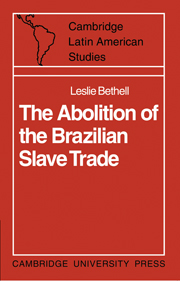Book contents
- Frontmatter
- Contents
- Preface
- Maps
- Abbreviations
- 1 First steps towards abolition, 1807–1822
- 2 Independence and abolition, 1822–1826
- 3 Brazil and the slave trade, 1827–1839
- 4 Treaty negotiations, 1830–1839
- 5 The British navy and the mixed commissions, 1830–1839
- 6 The extension of Britain's powers, 1839
- 7 Britain and the slave trade, 1839–1845
- 8 Slave trade, slavery and sugar duties, 1839–1844
- 9 Lord Aberdeen's Act of 1845
- 10 The aftermath of the Aberdeen Act
- 11 Changing attitudes and plans of action, 1845–1850
- 12 Crisis and final abolition, 1850–1851
- 13 The aftermath of abolition
- Appendix: Estimates of slaves imported into Brazil, 1831–1855
- Bibliography
- Index
5 - The British navy and the mixed commissions, 1830–1839
Published online by Cambridge University Press: 04 August 2010
- Frontmatter
- Contents
- Preface
- Maps
- Abbreviations
- 1 First steps towards abolition, 1807–1822
- 2 Independence and abolition, 1822–1826
- 3 Brazil and the slave trade, 1827–1839
- 4 Treaty negotiations, 1830–1839
- 5 The British navy and the mixed commissions, 1830–1839
- 6 The extension of Britain's powers, 1839
- 7 Britain and the slave trade, 1839–1845
- 8 Slave trade, slavery and sugar duties, 1839–1844
- 9 Lord Aberdeen's Act of 1845
- 10 The aftermath of the Aberdeen Act
- 11 Changing attitudes and plans of action, 1845–1850
- 12 Crisis and final abolition, 1850–1851
- 13 The aftermath of abolition
- Appendix: Estimates of slaves imported into Brazil, 1831–1855
- Bibliography
- Index
Summary
During the 1830s, as indeed throughout the long and costly campaign which lasted for more than half a century from 1807 to the mid-sixties, Britain's efforts for the suppression of the transatlantic slave trade at sea were concentrated on the coast of west Africa. Since 1807, when the sloops Pheasant and Derwent were first sent out to enforce Britain's own anti-slave trade legislation, a number of ships of the Royal Navy had been stationed on the west African coast where their duties had also come to include the suppression of the illegal foreign slave trade. After 1819, following the signing of the first right of search treaties with Portugal, Spain and the Netherlands, the coast from Cape Verde in the north to Benguela in the south (3,000 miles) had constituted a separate naval station. But from 1832 to 1839 the West African squadron came under the orders of the commanders-in-chief of the Cape of Good Hope station, successively Rear Admiral Frederick Warren (1831–4), Rear Admiral Sir Patrick Campbell (1834–7) and Rear Admiral George Elliot (1837–40). This combined West African and Cape station covered an enormous area from 26° W.to 75°E., and as far north as 23° 30′N. in the Atlantic and 10°S. in the Indian Ocean. Yet in 1836, for example, it accounted for only 14 of the 100 or so ships and a little over 1,000 of the 17,000 men on all foreign stations.
- Type
- Chapter
- Information
- The Abolition of the Brazilian Slave TradeBritain, Brazil and the Slave Trade Question, pp. 122 - 150Publisher: Cambridge University PressPrint publication year: 1970

